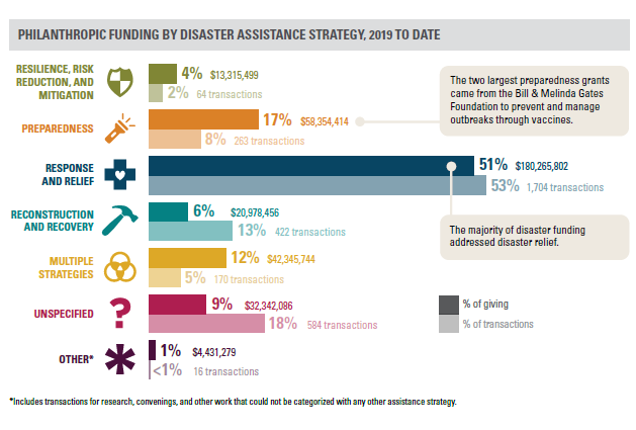New State of Disaster Philanthropy Report Shows That Funding Preparedness and Resilience Today Can Help Philanthropy Better Respond to Crises in the Future
Candid and the Center for Disaster Philanthropy’s report analyzes the global philanthropic response to disasters in 2019 and provides recommendations for funders to maximize their impact
Washington and New York (Nov. 10, 2021) — Candid and the Center for Disaster Philanthropy (CDP) released the eighth edition of their annual research report, Measuring the State of Disaster Philanthropy 2021: Data to Drive Decisions. The report shows why disaster-related funding in 2019 impacts philanthropy’s response to COVID-19 and other disasters today and in the future.
Candid and CDP examined available 2019 data on global disaster-related philanthropy, analyzing funding from foundations, bilateral and multilateral donors, the U.S. federal government, corporations, and donations through donor-advised funds (DAFs) and online platforms. They identified funding gaps and areas of opportunity so that crisis-affected communities have resources for immediate relief and long-term recovery.
Beginning this year and moving forward, Measuring the State of Disaster Philanthropy also offers specific, actionable insights for how donors can maximize their disaster-related giving.
Key findings
Drawing upon 12 data sources and analyzing 2019 data to date, Candid found almost $30 billion in disaster-related giving. Key findings include:
- Funding across most data sources declined in 2019 compared to 2018.
- Foundations and public charities funded $352 million for disaster and humanitarian crises.
- Organisation for Economic Co-operation and Development’s Development Assistance Committee (DAC) provided $22 billion in official development assistance. Non-DAC government donors and multilateral organizations contributed an additional $2.8 billion.
- The Federal Emergency Management Agency (FEMA) distributed $3.2 billion for U.S. disasters; the U.S. Department of Housing and Urban Development (HUD) allocated $1 billion in recovery efforts in 2019 for disasters that took place in 2017; and the U.S. Economic Development Administration (EDA) invested approximately $381.7 million in disaster-related projects.
- 55 percent of institutional funding was directed to natural hazards and severe weather; 41 percent was designated for general disasters; 4 percent was directed to complex humanitarian emergencies; and less than 1 percent was designated for human-made accidents.

Troubling disaster-assistance trends persist
As with previous years, this report sheds light on pervasive funding gaps. Candid and CDP
found that:
- 51 percent of funding by foundations and public charities was for response and relief efforts.
- 17 percent of funding went toward disaster preparedness.
- 6 percent went toward reconstruction and recovery.
- 4 percent supported resilience measures.

“It’s critical to fund for response and relief. Yet, it’s also crucial that philanthropy funds preparedness and mitigation, which helps reduce the impact of disasters,” said Grace Sato, director of research. “Communities also require sustained funding to support the long road to recovery.”
Ways funders can maximize their disaster-related giving
“Disaster philanthropy might be a drop in the bucket compared to government funding, but it plays an essential role in helping communities prepare for, respond to, and recover from global disasters and humanitarian crises,” says Regine A. Webster, vice president at CDP.
In the report, CDP recommends several ways that donors can be strategic in their future disaster-related giving to maximize their impact. These include:
- Support underfunded areas of the disaster lifecycle, particularly preparedness, resilience, and recovery.
- Enable advocacy and community organizing efforts, which can help residents activate and engage to affect systemic change.
- Provide quick, unrestricted, and flexible multi-year financial support.
- Support local nonprofits and knowledge—in the U.S. and internationally—by funding organizations that focus on marginalized populations.
- Report funding data to Candid and ensure that grant descriptions are clear and explicit.
CDP and Candid will host a discussion on the report’s key findings during a free webinar on Thursday, November 18, at 2 p.m. EDT/1 p.m. CDT/12 p.m. MDT/11 a.m. PDT. CDP President and CEO Patty McIlreavy will moderate the discussion. Panelists include Supriya Kumar, global partnerships research manager at Candid, and Colin Foard, manager, fiscal federalism initiative at The Pew Charitable Trusts.
Measuring the State of Disaster Philanthropy 2021: Data to Drive Decisions is available at doi.org/10/gm29bv.
About Candid
Every year, millions of nonprofits spend trillions of dollars around the world. Candid finds out where that money comes from, where it goes, and why it matters. Through research, collaboration, and training, Candid connects people who want to change the world to the resources they need to do it. Candid’s data tools on nonprofits, foundations, and grants are the most comprehensive in the world. In 2019, Foundation Center and GuideStar joined forces to become Candid, a 501(c)(3) nonprofit organization. Find out more at candid.org and on Twitter @CandidDotOrg.
About the Center for Disaster Philanthropy
The Center for Disaster Philanthropy leverages the power of philanthropy to mobilize a full range of resources that strengthen communities’ ability to withstand disasters and recover equitably when they occur. It provides expert advice and resources while managing domestic and international disaster funds on behalf of corporations, foundations and individuals through targeted, holistic and localized grantmaking. Find out more at disasterphilanthropy.org and on Twitter @funds4disaster.
CDP mobilizes philanthropy to strengthen communities’ ability to withstand disasters and recover equitably when they occur. It provides expert advice and educational resources, supports diverse coalitions and manages domestic and international disaster funds on behalf of corporations, foundations and individuals through targeted, holistic and localized grantmaking. Find out more at disasterphilanthropy.org and on X and LinkedIn.